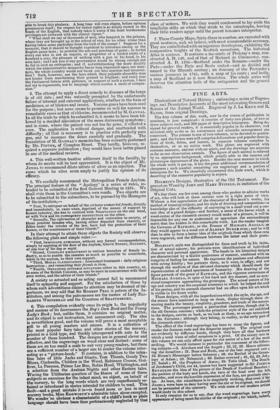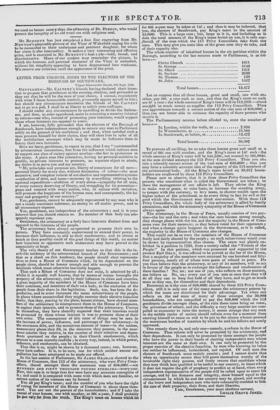HOLBEIN . S Designs, illustrative of the Old Testament. En- graved on
Wood bf Jonx and MARY SYFIELD, in imitation of the Original Cuts.
We fear there are few even among those who profess to admire works of art, who will look at these curious cuts in a right point of view. Without a due appreciation of the character of HOLBEIN'S works, his
method of treating subjects, and his style of drawing and composition—a knowledge also of the difficulty of conveying in a small wood cut a cor-
rect idea of a grand design—and further, a sense of the havoc which Vi
wood-cutter of the sixteenth century would make of a picture, it will be impossible for any one to understand or appreciate the extraordinary merit that lies hidden in this remarkable work. Let the reader imagine
the Cartoons of RAPHAEL or the Frescos of MICHAEL ANGELO, as they would appear in a wood cut of ALBERT DUREN. even ; and he will
then be able to form a better idea of the originals from which these cuts were engraved, and the difference between the latter and their proto- types.
HOLBEIN'S style was distinguished for force and truth in his imita- tion of actual nature; his portraits were identifications of individual character and personal appearance. The heads in his historical designs are characterized by a Gothic quaintness of manner, combined with an integrity of feeling for nature. He expresses the passions and affections with strong fidelity ; but portrays them, as it were, in effigy, and not through the medium of that elevated character which should mark the representation of exalted specimens of humanity. His drawing of the figure partook of the grace of RAPHAEL, and the vigorous correctness of MICHAEL ANGELO, in spite of his hard and dry manner, and an occa-
sional meagreness approaching the grotesque. The actual of his age and country was the corporeal tenement in which he lodged the soul of his genius, and its uncouth character had an effect upon his art which is visible in his finest works.
These designs, with all the imperfectionswhich the style, the age, and the Means have combined to heap on them, display through these ob- scuring media the beauty, simplicity, grandeur, and truth of the concep- tions. The personages possess a patriarchal character, though clad in the old German costume ; while the primitive style of the art exhibited in the designs, carries us back, as we look at them, to an age antecedent to the Cartoons ; although they belong, in reality, to the early part of the sixteenth century. The effect of the wood engravings has been to stunt the figures, and render the features rude and the draperies angular. The original cuts are evidently by different hands, though they have all that hardness which a total want of relief occasions in a print. Of the ninety cuts in this volume we can only afford space for the notice of a few of the most striking. We would instance in particular the treatment of the follow- ing subjects.-3. Abraham and the Angels ; 26,27, 28. Moses address. ing the Israelites ; 31. Boaz and Ruth, one of the best engraved cuts ; 43. Hiram's Messenger before Solomon ; 50. the Recital of the Genea- logy of Adam ; 59. Nehemiah ; 60. Esther crowned ; 61, 62, 63. Job; 78. Isaiah ; 81. the Prophecy of Amos; 85. Tobit blind. The Death. of Jeroboam's Child, cut 44, cannot but have suggested to Sir JOSHUA. REYNOLDS the idea of his picture of the Death of Cardinal Beaufort; the position of the body and hands, the turn of the head over the left, shoulder, and even the horrible expression of the face, are precisely simi- lar. Aeleast, the coincidence is so singularly striking, that even if Sir JOSHUA were here to deny having seen the cnt or its original, we should not be persuaded of the contrary. We wish some of our modern artists
would study in this school.
It only remains for us to say, that the wood engravings have every. appearance of being exact fac similes of the originals ; for which, indeed, we need no better surety than the editorship of Dr. DIBDIN, who would protect the integrity of an old wood cut with religious zeal.



























 Previous page
Previous page